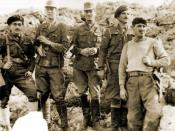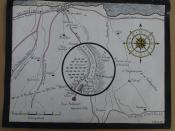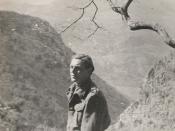Book Review for Ill Met by MoonlightIll Met by Moonlight, an actual account of W. Stanley Moss' escapades in Crete took place in 1944. Prior to this, the allies controlled the small island off the coast of Greece. The German plan, Operation Mercury, was to capture Crete with airborne troops with a glider regiment and a parachute regiment to land at Maleme and Carea on May 20, 1941. These troops were followed by two parachute battalions at Retimo and four at Heraklion. Additional troops came form a mountain division which was to be partly landed on captured airfields, with the remainder taken to Crete by sea. The ensuing fighting was bloody and vicious with the initially dropped Germans suffering severe losses. In fact, so severe was the loss on Hitler's men that his paratroopers were never again used in such a large-scale operation. However, further landings in the open country in the west provided sufficient forces for the Germans to capture Maleme airfield.
This was essential to the success of the German operation who were able to retain it despite strong New Zealand counter-attacks. The loss of Maleme airfield threatened the whole allied position in Crete since the Germans, with air-superiority, were able to bring in reinforcements and supplies. Despite Australian success at Retimo and Heraklion, German pressure continued to rise, and on May 27, 1941, General Wavell ordered the allied forces to abandon the island. The 24th Australian Battalion at Heraklion was to leave first. During the 350-mile trip, the ships they were trying to escape on were under constant attack from waves of German Stukas. About 600 men were killed. After that, the naval authorities decided there was no hope of lifting troops from Canea, Suda Bay, and Retimo. The forces were ordered to fight their way out of the towns and strike across the island to the village of Sfakia where the navy would meet them. About 15,000 men were embarked from Sfakia and Heraklion with about 12,000 being taken as prisoner. The Germans lost some 4,000 men killed and 2,500 wounded on Crete. This Nazi occupied Crete is the setting of the book.
Ill Met by Moonlight is an actual account by W. Stanley Moss of his adventures in Crete. He and his good friend Patrick Leigh-Fermor (Paddy) were both serving with the Special Forces Unit in the Middle East when they decided to kidnap the German General Kreipe, Commander of the Sevastapol Division in Crete, and bring him back to allied occupied Cairo in an attempt to lower German morale. The first step in the plan was for Moss to get onto the island without being spotted and killed by the Germans. After twelve airborne attempts, Moss finally arrived on the island by sea. He met up with Paddy and began to make plans for the kidnapping. Together, they made their way through the mountainous terrain on foot, meeting up with a cast of characters who would help them in executing their plan. The group relied upon the Cretan hatred of the Germans; for the locals gave the group anything they needed from food to shelter while risking their lives. The group then met up with Micky, who was the chief agent in Heraklion. He knew a house in Knossos which was next door to the General's house. The plan was then set into motion. Micky was able to lay his hands on a couple of German uniforms which fit Moss and Paddy reasonably well. In the meantime, Elias had been studying the coming and goings of the General's car. He had also prepared his electric-bell system which was agreed that the signal should be: one ring if the General's car was unaccompanied, two if there was an escort.
Their plan formulated as follows based upon information supplied to them. The General traveled twice daily from the Villa Ariadne at Knossos to his headquarters at Ano Arkhanais. His average working hours were from 9 A.M. to 1 P.M. and from 4 to 8 or 8:30 P.M. The best moment to attempt the abduction was during his last journey home because by that time it was fairly dark. In addition, the guard at the Villa Ariadne, imagining that the General had stayed at his headquarters for dinner or a game of cards would not become immediately suspicious of his absence. These facts were based upon information supplied by Micky and Elias. During their reconnaissance Paddy and Micky had discovered what they considered an ideal spot for the ambush. This was a T-junction where the Arkhanais road met the Houdetsi-Heraklion road, and there any car traveling toward Knossos would inevitably have to slow down almost to a standstill. At this point, the two sides of the road were highly banked, and all three sides were bordered by ditches which were deep enough to afford concealment. The electric bell was an essential part of the plans. Both Elias and Micky were positioned on a hillock about 300 meters up the road with a view to keep a lookout for the General's car. A length of wire was unrolled from their position to the T-junction, a bell being placed at the other end. Thus when the General's car approached, they rang the bell to warn the others. In the guise of German police corporals, equipped with red lamps and traffic signals, Paddy and Moss stood in the center of the road as the car approached and signaled it to stop. They then walked towards it, Paddy on the left and Moss on the right. On a given word, the doors were ripped opened: Paddy dealt with the General while Moss dealt with the chauffeur. Paddy, Manoli, Nikko, and Stratis carried the thrashing General to the back seat of the car. Moss got into the driver's seat and they began their long trek to the rendezvous on Mount Ida. Several hundred miles later, they ditched the car and went the rest of the way on foot back through the mountains.
The journey back was even more treacherous than the journey in; for now the Germans were searching the countryside specifically for them and their General. The General himself was cooperative and because he did not try to escape was treated as one of the group. After several days of traveling, distressing news arrived to the group: there were 200 Germans stationed on the beach that they had intended to use for their departure. This meant that they had to find a new and suitable beach, make contact with a wireless set, send a new message to Cairo informing headquarters of the change, and wait several more days for the motor-launch to arrive. Almost two-weeks later, they were able to get a message to Cairo and received news that a ship was on its way to rescue them. After a nerve-racking arrival of the boat and the frustration of no one knowing Morse code, the group was finally rescued, loaded on the boat, and sailed back to Egypt.
I thought that this book was extremely interesting. Because it was Moss' personal diary, some of the characters, places, events, and some phrases were difficult to understand. For the most part, the accompanying explanatory notes helped to relieve the confusion. The explanatory notes were also necessary because in the diary, Moss was not able to include original plans, names of agents, and some place names for fear that it would fall into the wrong hands.
As someone who enjoys military books and stories, I found this book to be not only informative on a topic I didn't know anything about, but also entertaining. It raised my curiosity not only about Crete's involvement in WWII, but also about the individual characters met through the course of the book. It is interesting to me that so many lives were lost over the little agrarian island of Crete.
I found that the wartime relationships between the various groups on the island also to be fascinating. First, I was stunned by the way that the Nazis treated the Cretan locals and the complete brutality they displayed. Shooting and burning whole villages of peasants with no real way to fight back appalled me. After coming to this realization, it was easy for me to understand why the Cretans were so willing to risk everything they had, including their lives, to help the British against the Germans. But after Moss had painted the picture of the almost barbaric Germans, he introduces us to the General, who although he is a German, doesn't really seem so bad. It really impressed me how, despite language barriers, the General and Moss got along. I was also surprised at how the General didn't try to escape from his kidnappers. In fact I found their relationship almost humorous when they would fight over a blanket or when the General insisted that his shoulder was broken, even though it was only bruised.
Moss' writing style was effective for telling his story. Because he was a young soldier, I didn't expect the kind of language and detail he used. He explains that because most of the journey was spent hiding from the enemy, he had plenty of time to write detailed entries. For instance, when describing the island he says he had seen it as "a faerie castle, turrets above the clouds, a dream in cotton wool ⦠as a frigid wedding cake ⦠like a moon bathed mosaic." Description similar to this impressed me very much since this was a man who had seen years of death, destruction, and cruelty.
Altogether I liked this book for its lively style, and for the way Moss describes the characters involved, most of whom seem larger than life. Because it is his diary, the content is probably slightly biased, but I think it adds to the atmosphere. Although he only shows one side of the story, I think that his portrayal of Crete during WWII was fairly accurate.




